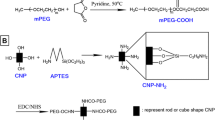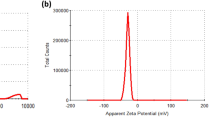Abstract
To develop new nanoparticle materials possessing antioxidative capacity with improved physical characteristics, we have studied titanium-doped cerium oxide (CeTiO2) nanoparticles. CeTiO2 nanoparticles had mode diameters in the range of 15–20 nm. These nanoparticles demonstrated catalase activity, and did not promote the activation of hemolytic or cytolytic pathways in living cells. Using surface plasmon resonance-enhanced microscopy, we find that these nanoparticles associate with cells. Transmission electron microscopy studies demonstrated that these nanoparticles accumulate within the vacuolar compartment of cells. Importantly, CeTiO2 nanoparticles decrease hydrogen peroxide-mediated apoptosis of cells as judged by the reduced cleavage of a caspase 3-sensitive label. CeTiO2 nanoparticles may contribute to deflecting tissue damage in a broad spectrum of oxidant-mediated diseases, such as macular degeneration and Alzheimer’s disease.








Similar content being viewed by others
References
Buettner KM, Rinciog CI, Mylon SE (2010) Aggregation kinetics of cerium oxide nanoparticles in monovalent and divalent electrolytes. Colloids Surf A 366:74–79
Caldwell RB, Bartoli M, Behzadian MA, El-Remessy AE, Al-Shabrawey M, Platt DH, Liou GI, Caldwell RW (2005) Vascular endothelial growth factor and diabetic retinopathy: role of oxidative stress. Curr Drug Targets 6:511–524
Cao D, Boxer LA, Petty HR (1993) Deposition of reactive oxygen metabolites onto and within living tumor cells during neutrophil-mediated antibody-dependent cellular cytotoxicity. J Cell Physiol 156:428–436
Chen J, Patil S, Seal S, McGinnis JF (2006) Rare earth nanoparticles prevent retinal degeneration induced by intracellular peroxides. Nat Nanotechnol 1:142–150
Clark AJ, Diamond M, Elfline M, Petty HR (2010) Calicum microdomains form within neutrophils at the neutrophil-tumor cell synapse: role in antibody-dependent target cell apoptosis. Cancer Immunol Immunother 59:149–159
Clark A, Zhu A, Sun K, Petty HR (2011) Cerium oxide and platinum nanoparticles protect cells from oxidant-mediated apoptosis. J Nanopart Res 13:5547–5555
Colon J, Herrera L, Smith J, Patil S, Komanski C, Kupelian P, Seal S, Jenkins DW, Baker CH (2009) Protection from radiation-induced pneumonitis using cerium oxide nanoparticles. Nanomedicine 5:225–231
Das M, Patil S, Bhargava N, Kang JF, Riedel LM, Seal S, Hickman JJ (2007) Auto-catalytic ceria nanoparticles offer neuroprotection to adult rat spinal cord neurons. Biomaterials 28:1918–1925
D’Autréaux B, Toledano MB (2007) ROS as signalling molecules: mechanisms that generate specificity in ROS homeostasis. Nat Rev Mol Cell Biol 8:813–824
Elswaifi SF, Palmieri JR, Hockey KS, Rzigalinski BA (2009) Antioxidant nanoparticles for control of infectious disease. Infect Disord Drug Targets 9:445–452
Feng X, Sayle DC, Wang ZL, Paras MS, Santora B, Sutorik AC, Sayle TX, Yang Y, Ding Y, Wang X, Her YS (2006) Converting ceria polyhedral nanoparticles into single-crystal nanospheres. Science 312:1504–1508
Gao L, Zhuang J, Nie L, Zhang J, Zhang Y, Gu N, Wang T, Feng J, Yang D, Perrett S, Yan X (2007) Intrinsic peroxidase-like activity of ferromagnetic nanoparticles. Nat Nanotechnol 2:577–583
George S, Lin S, Ji Z, Thomas CR, Li L, Mecklenburg M, Meng H, Wang X, Zhang H, Xia T, Hohman JN, Lin S, Zink JI, Weiss PS, Nel AE (2012) Surface defects on plate-shaped silver nanoparticles contribute to its hazard potential in a fish gill cell line and zebrafish embryos. ACS Nano 6:3745–3759
Kanwar M, Chan PS, Kern TS, Kowluru RA (2007) Oxidative damage in the retinal mitochondria of diabetic mice: possible protection by superoxide dismutase. Invest Ophthalmol Vis Sci 48:3805–3811
Kawaji T, Elner VM, Yang DL, Clark A, Petty HR (2011) Nuclear translocation of glyceraldehyde 3-phosphate dehydrogenase in human retinal pigment epithelium induced by oxidative stress. Redox Reports 16:24–26
Keller AA, Wang H, Zhou D, Lenihan HS, Cherr G, Cardinale BJ, Miller R, Ji Z (2010) Stability and aggregation of metal oxide nanoparticles in natural aqueous matrices. Environ Sci Technol 44:1962–1967
Korsvik C, Patil S, Seal S, Self WT (2007) Superoxide dismutase mimetic properties exhibited by vacancy engineered ceria nanoparticles. Chem Commun (Camb) 14:1056–1058
Kowluru RA, Kowluru V, Xiong Y, Ho YS (2006) Overexpression of mitochondrial superoxide dismutase in mice protects the retina from diabetes-induced oxidative stress. Free Radic Biol Med 41:1191–1196
Mahmoudi M, Lynch I, Ejtehadi MR, Monopoli MP, Bombelli FB, Laurent S (2011) Protein-nanoparticle interactions: opportunities and challenges. Chem Rev 111:5610–5637
Mahmoudi M, Saeedi-Eslami SN, Shokrgozar MA, Azadmanesh K, Hassanlou M, Kalhor HR, Burtea C, Rothen-Rutishauser B, Laurent S, Sheibani S, Vali H (2012) Cell “vision”: complementary factor of protein corona in nanotoxicology. Nanoscale 4:5461–5468
McCubrey JA, Lahair MM, Franklin RA (2006) Reactive oxygen species-induced activation of the MAP kinase signaling pathways. Antioxid Redox Signal 8:1775–1789
Ndozangue-Touriguine O, Hamelin J, Bréard J (2008) Cytoskeleton and apoptosis. Biochem Pharmacol 76:11–18
Niu J, Azfer A, Rogers LM, Wang X, Kolattukudy PE (2007) Cardioprotective effects of cerium oxide nanoparticles in a transgenic murine model of cardiomyopathy. Cardiovasc Res 73:549–559
Ohno Y, Gallin JI (1985) Diffusion of extracellular hydrogen peroxide into intracellular compartments of human neutrophils. Studies utilizing the inactivation of myeloperoxidase by hydrogen peroxide and azide. J Biol Chem 260:8438–8446
Osborn NM (2008) Involvement of oxidative stress in the pathogenesis of glaucoma. In: Zierhut M, Cadenas E, Rao NA (eds) Free Radicals in Ophthalmic Disorders. Informa Healthcare, New York
Pal S, Tak YK, Song JM (2007) Does the antibacterial activity of silver nanoparticles depend on the shape of the nanoparticle? A study of the Gram-negative bacterium Escherichia coli. Appl Environ Microbiol 73:1712–1720
Petty HR, Francis JW (1985) Novel fluorescence method to visualize antibody-dependent hydrogen peroxide-associated “killing” of liposomes by phagocytes. Biophys J 47:837–840
Schubert D, Dargusch R, Raitano J, Chan S-W (2006) Cerium and yttrium oxide nanoparticles are neuroprotective. Biochem Biophys Res Comm 342:86–91
Sebbagh M, Renvoizé C, Hamelin J, Riché N, Bertoglio J, Bréard J (2001) Caspase-3-mediated cleavage of ROCK I induces MLC phosphorylation and apoptotic membrane blebbing. Nat Cell Biol 3:346–352
Singh N, Cohen CA, Rzigalinski BA (2007) Treatment of neurodegenerative disorders with radical nanomedicine. Ann N Y Acad Sci 1122:219–230
Tarnuzzer RW, Colon J, Patil S, Seal S (2005) Vacancy engineered ceria nanostructures for protection from radiation-induced cellular damage. Nano Lett 5:2573–2577
Wu GS, Zhang J, Rao NA (1997) Peroxynitrite and oxidative damage in experimental autoimmune uveitis. Invest Ophthal Vis Sci 38:1333–1339
Zhu A, Sun K, Petty HR (2012) Titanium doping reduces superoxide dismutase activity, but not oxidase activity, of catalytic CeO2 nanoparticles. Inorg Chem Commun 15:235–237
Acknowledgments
This study was supported by the Mildred E. Swanson Foundation, the Nathan Shock Center (NIH AG013283), the NIH Grant P30EY007003, and Research to Prevent Blindness.
Author information
Authors and Affiliations
Corresponding author
Rights and permissions
About this article
Cite this article
Clark, A., Zhu, A. & Petty, H.R. Titanium-doped cerium oxide nanoparticles protect cells from hydrogen peroxide-induced apoptosis. J Nanopart Res 15, 2126 (2013). https://doi.org/10.1007/s11051-013-2126-z
Received:
Accepted:
Published:
DOI: https://doi.org/10.1007/s11051-013-2126-z




